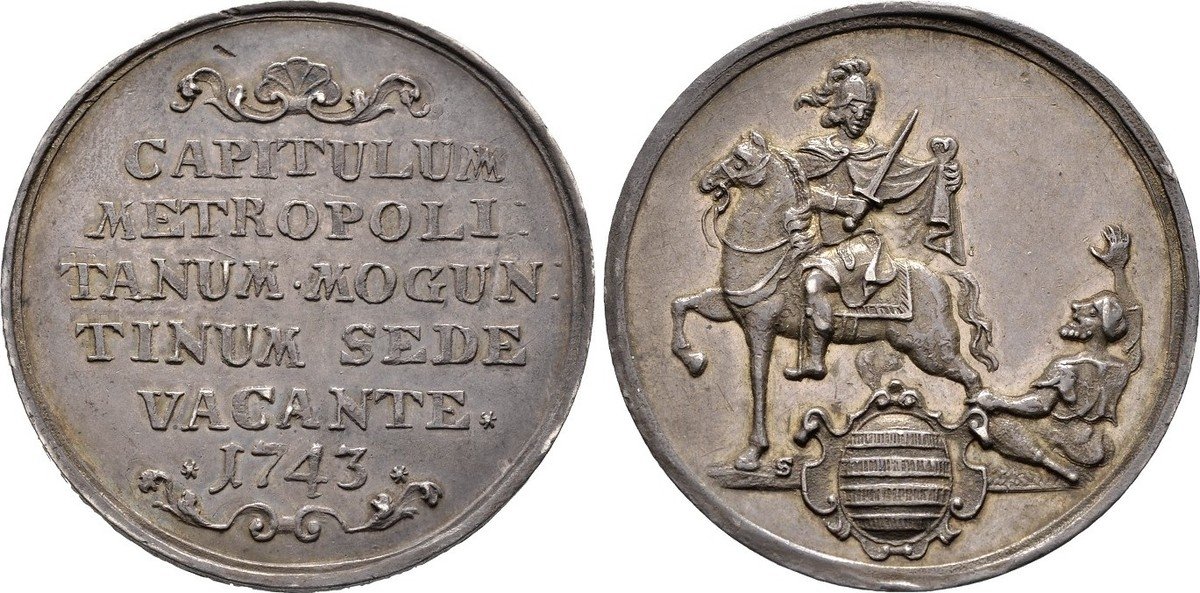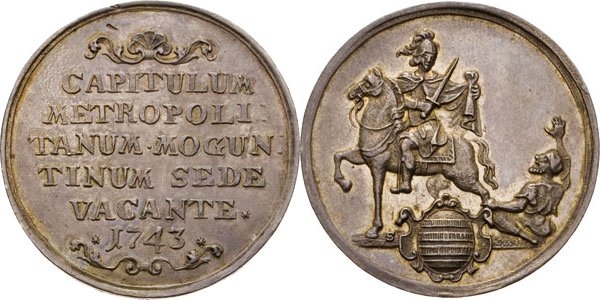newp - 1743 Mainz shautaler
 worldcoinguy
Posts: 3,030 ✭✭✭✭✭
worldcoinguy
Posts: 3,030 ✭✭✭✭✭
It seems as if my numismatics momentum had slowly sputtered to a halt this spring. Besides being busy by family and work, I just simply had not seen much to get my heart beating. This week something popped onto my radar out of the blue and the spark has returned. It is my first purchase in almost 6 months. I feel like a kid waiting for Santa Claus to arrive. I have really become entranced with the Mainz sede vacante issues featuring St Thomas. Mintage believed to be in the hundreds of pieces but I cannot find a definitive source with a precise figure (any ideas?).
Mainz - 1743 1/2 Schautaler - Sedisvakanz (Sede Vacante)
Walther 509 Prince Alexander 668 Zepernick 19; 12.04 g .; 37 mm
Very scarce issue – described as ‘very rare’ in each of the 3 auctions I can find in last 8 years.
Here is the pic from the 2016 auction by Dr Busso Peus
Here is a pic of what I believe is the same piece from a 2010 auction by Leipziger Münzhandlung
Comments
Cool item. I know nothing about this and can't help you with the mintage though -- sorry!
How does one get a hater to stop hating?
I can be reached at evillageprowler@gmail.com
Very nice addition!
My YouTube Channel
nice, and no need to guess or wonder, it is one and the same!
Solid purchase Brent. I couldn't find the mintage,
-~-~-~-~-~-~-~-~-~-~-~-~-~-~-~-~-~-~-~-~-~-~-~-~-~-~-~-~-~-~-~-~-~-~-~-~-~-~-~-~-~-~-~-~-~-~-~-~-~-~-~-~-
My sets: [280+ horse coins] :: [France Sowers] :: [Colorful world copper] :: [Beautiful world coins]
-~-~-~-~-~-~-~-~-~-~-~-~-~-~-~-~-~-~-~-~-~-~-~-~-~-~-~-~-~-~-~-~-~-~-~-~-~-~-~-~-~-~-~-~-~-~-~-~-~-~-~-~-
Saint Martin of Tours, I believe. I have been looking for a numismatic item featuring him. An order from Germany disappeared in the post.
DPOTD
Harasha - of course! I stand corrected. A quick review of Wikipedia sets the record straight:
Saint Martin of Tours (316 - 397) was Bishop of Tours, whose shrine in France became a famous stopping-point for pilgrims on the road to Santiago de Compostela in Spain. He has become one of the most familiar and recognizable Christian saints, sometimes venerated as a military saint. He is considered to be the patron saint of Mainz, and the the legend of his cloak is what is often portrayed on the Mainz coinage:
While Martin was a soldier in the Roman army and stationed in Gaul (modern-day France), he experienced a vision, which became the most-repeated story about his life. One day as he was approaching the gates of the city of Amiens, he met a scantily clad beggar. He impulsively cut his military cloak in half to share with the man. That night, Martin dreamed of Jesus wearing the half-cloak he had given away. He heard Jesus say to the angels: "Martin, who is still but a catechumen, clothed me with this robe." (Sulpicius, ch 2). In another version, when Martin woke, he found his cloak restored to wholeness. The dream confirmed Martin in his piety, and he was baptised at the age of 18.
The part kept by himself became the famous relic preserved in the oratory of the Merovingian kings of the Franks at the Marmoutier Abbey near Tours. During the Middle Ages, the supposed relic of St. Martin’s miraculous cloak, (cappa Sancti Martini) was carried by the king even into battle, and used as a holy relic upon which oaths were sworn. The cloak is first attested in the royal treasury in 679, when it was conserved at the palatium of Luzarches, a royal villa that was later ceded to the monks of Saint-Denis by Charlemagne, in 798/99.
The priest who cared for the cloak in its reliquary was called a cappellanu, and ultimately all priests who served the military were called cappellani. The French translation is chapelains, from which the English word chaplain is derived.
A similar linguistic development took place for the term referring to the small temporary churches built for the relic. People called them a "capella", the word for a little cloak. Eventually, such small churches lost their association with the cloak, and all small churches began to be referred to as "chapels".